Port3 Network Research Report From Web2 to Web3, Building a New Social Data Layer
Port3 Network Research Report From Web2 to Web3, Building a New Social Data LayerProject Introduction
Port3 Network is an all-in-one social application project that creates, utilizes, and develops Web3 identities by aggregating and standardizing off-chain/on-chain data, building a social data layer.
The SoQuest platform of Port3 Network is one of the widely-targeted Web3 Quest platforms, helping projects establish Web3 communities and aggregate various project activities and information. Project teams can launch activities to attract user participation, and users can earn rewards while participating in these activities. In addition, Port3 has established an interconnected suite of products, including Robot Matrix, SoQuest Task Platform, SoGraph Analysis Platform, etc., with the goal of helping users bridge the gap with Web2 and accelerate the transition to Web3.
Author
Elma Ruan, a senior research analyst at Shi Chain Investment Research, holds dual master’s degrees in marketing and finance from an Ivy League school. With 5 years of experience in Web3, she specializes in various fields such as DeFi and NFT. Before entering the crypto industry, she worked as an investment manager at a large securities firm.
1. Research Focus
1.1 Core Investment Logic
In recent years, the Web3 field has rapidly emerged, but it has also revealed a series of common problems:
- Opinion Change in Speaker of the U.S. House of Representatives may be detrimental to the crypto world.
- Former close friend to testify against SBF, list of other witnesses revealed.
- Weekly Financing Report | 16 public financing events; Oracle Supra completes over $24 million financing, with participation from Animoca Brands, Coinbase Ventures, and others.
● Strong demand for Web3 project growth: Web3 projects need strong growth strategies to attract more users, but there is currently no mature GTM (Go-to-Market) methodology, especially different from traditional Web2 growth hacking methods, making it difficult to apply many traditional marketing tactics.
● High entry barriers for Web2 users: For Web2 users, entering Web3 requires overcoming certain technical and conceptual barriers, which is a major obstacle to user influx.
● High proportion of loss in traffic distribution: During the process of traffic distribution, Web3 projects face a high user churn rate, which poses a challenge to project growth.
● Lack of native growth tools for Web3: Currently, there is a lack of native growth tools for Web3, making project growth difficult.
● Lack of refined operation for Web3 projects: The lack of refined operation for Web3 projects, including data analysis, restricts the sustainable development of projects.
Port3 Network focuses on building the Web3 social data infrastructure, and provides a one-stop social layer along with corresponding application layer services to address the above-mentioned Web3 problems, providing comprehensive support for the development of Web3. Its business scope covers comprehensive social data analysis and application services, Bot application services, Web3 task and mining ecosystem, as well as comprehensive social data analysis and insight platform.
The community management function of Port3 Network is very powerful. Utilizing the SoQuest platform, it can help project parties establish and manage an active and orderly community, respond to user questions and needs in a timely manner, and enhance user satisfaction and trust. Through effective community operation, projects can retain more loyal users and establish a solid foundation for long-term development.
Secondly, Port3 Network has quickly attracted a large number of potential users with its strong user acquisition capabilities. Its unique Ask Me Anything (AMA) feature (assisted by a Bot) allows project teams to have direct and in-depth interactions with users, significantly increasing user engagement and stickiness. In addition, Port3 Network provides various social media integrations such as TG Bot and Discord Bot, which provide extensive exposure channels for projects, further expanding the user base. These types of bots also support features such as information reminders, reward distribution, and data analysis. The information reminder feature helps projects timely push important information to users, keeping their attention. Currently, data analysis, which has not yet been implemented, becomes a key optimization strategy for projects. If it can truly establish a social data layer that connects Web2 and Web3, it will have a comprehensive data model in the entire SocialFi field, providing a solid infrastructure for SocialFi. This can achieve in-depth analysis of user behavior data and provide a one-stop platform service, marking a crucial step from Web2 to Web3 in a true sense.
However, it is worth considering that although projects proposing solutions for the problems of Web3 are emerging, Web3 has not yet formed a complete growth methodology, and growth is still in a relatively blind stage. Whether in Web2 or Web3, acquiring customers, activating them, retaining them, and recommending them are still the core logic and processes of growth in the social track. In Web3, many common gameplay methods have emerged in the customer acquisition stage, such as AMA, Giveaway, etc., which provide various possibilities for project customer acquisition. With the continuous development of the ecosystem, the number of projects continues to increase, and many multidimensional DApps focusing on user acquisition, community management, information reminders, reward distribution, and data analysis have emerged. These tools enrich the possibilities of growth but also bring overlap between projects. In the future, the development direction of these projects will inevitably move towards refined operations, growth strategies, or one-stop platform services. Regardless of which direction is chosen, it will be crucial to relatively accurately retain those loyal seed users.
Specifically, Port3 Network performs well in terms of user overlap, but this also means that its market positioning and user attraction may be similar to other platforms, especially highly overlapping with Galxe users, possibly due to similar collaborative usage requirements or reward mechanisms. In terms of functionality, although Port3 Network covers modules such as on-chain tasks, off-chain tasks, reward distribution, data analysis, and multi-scenario coverage, it does not have any outstanding features compared to other platforms. Data analysis functionality is crucial for platform growth, and the underlying data and analysis products of Port3 Network are still to be released and tested for their functionality. Whether it is a platform like Galxe that focuses on refined operations of DID or a platform like Port3 that aims to provide one-stop operations, trade-offs need to be made, as spreading too widely in one-stop operations may not yield significant results. Moreover, the overall completeness of functionality is not directly proportional to traffic. Therefore, project teams need to emphasize market strategy more, especially in connecting the B-end and C-end, they need to highlight the uniqueness and innovation of task publishing through differentiated product feature design, highlighting their unique characteristics and avoiding homogeneous competition, ensuring the competitiveness of their market.
In the current bear market environment, Port3 Network prioritizes the selection of lower cost and more efficient underlying ecosystems, such as BNBChain, Polygon, ZK series, OP series Layer2, etc., to ensure high-speed and low-cost services for users. This choice is more in line with and meets the efficiency and profit expectations of current users compared to chasing hotspots during a bull market.
Another question worth considering is that in the current bear market phase, overall, the majority of users are in a stock state, and fund flow is relatively limited. It becomes crucial to achieve stable growth while retaining existing users. In this regard, cooperation and linkage with entertainment sectors such as GameFi can be considered, and targeted operational strategies can be formulated to attract more users and projects.
Currently, from the perspective of product and operational data, Port3 Network demonstrates high potential. However, achieving the perfect integration of Web2 and Web3 social applications is very challenging, and achieving the convenience of Web2 will be the most important and mature indicator. In the current situation where the head effect has already formed, if Port3 Network can truly solve this problem in the future, it will undoubtedly become a leading enterprise in this field. For investors, it is best to closely monitor the dynamics of this project in the short and medium term, especially its cooperation with leading platforms in the field.
1.2 Valuation
The latest round of financing on August 15, 2023 amounted to $10 million. According to founder Anthony, the valuation of this round of financing is $80 million.
2. Project Overview
2.1 Business Scope
The core business of Port3 Network is to establish a decentralized social data layer, collect and analyze a wide range of user activities, including on-chain and off-chain data from Web2 and Web3 sources. These comprehensive data can be used for various applications, such as market-related indicators, member lists, social/spam activity levels, sentiment indicators, etc. By providing an accessible and powerful social data layer for all Web3 use cases, SoQuest is one of Port3’s main products and has the potential to become one of the most popular Web3 Quest platforms. It helps projects build Web3 communities and aggregate various project activities and information. The platform provides a unique way for projects to interact with the community and incentivize participation, which helps build a strong and loyal user base.
2.2 Past Development and Roadmap
Time Event
2022-04-18 Announced strategic partnership with IoTeX; reached partnership with 5Degrees;
2022-4-25 Announced collaboration with tofuNFT and Automata Network; announced collaboration with Gametaver and gave away NFTs
2022-5-9 SoGraph Alpha testing; launched the first Port3 DAO tool: SoGraph Airdrop Bot
2022-05-27 Released SoGraph.xyz Alpha testing guide
2022-06-02 Official announcement of cooperation with Degis; SoGraph.xyz upgrade; Official announcement of cooperation with PlatON and gifting NFTs
2022-6-20 Official announcement of cooperation with SkyArk and giveaway activities; Port3 SoGraph.xyz new features available; Official announcement of cooperation with Mirror World and giveaway activities
2022-6-28 Official announcement of cooperation with .bit, jointly exploring the “SocialFi+DID” field; SoGraph.xyz update, activities online; Official announcement of cooperation with Relation: developing the first product related to oracles – social data oracle;
FindTruman Genesis NFT airdrop for the community; Official announcement of giveaway activities with REI Network and Nawarat; Official announcement of cooperation with myMessage;
2022-7-21 NFTScan and Port3 Network strategic cooperation on NFT data; Participating in the Binance Labs MVB V incubation program; Launching SoQuest, replacing Gleam and Premint; Official announcement of cooperation with OpenLeverage; Official announcement of cooperation with 4EVERLAND + NFTG giveaway activities
2022-08-05 Open application for SoQuest Beta access; SoGraph.xyz launched on BitKeep and Token Pocket; Official announcement of cooperation with Meson Network
2022-08-17 Port3 SoulBound token design competition, lasting for 22 days
2022-09-15 Release of Port3 Ambassador Program introduction; NFTFair platform API docking
2022-9-24 Integration of SoQuest with Binance’s $BAB token; API connection with Galxe (formerly Project Galaxy); Connection with Martain Wallet and Petra Wallet on Aptos; Full integration with Pontem Wallet in the Aptos Ecosytem; Announcement of cooperation with RadioCacaNFT;
2022-10-24 Full support for on-chain task verification of Venus Protocol; SoQuest launches NFT minting feature, “proof of work” functionality; Support for Kucoin Wallet Chrome extension; Official announcement of cooperation with Automata Network for SoQuest’s minting feature;
2022-11-17 Weight NFT minting begins, lasting for 10 days; Jointly organizing the 2022 World Cup Pick’em event with Plena
2022-12-05 SoQuest upgrades to a new UI and introduces a new user interface
2022-12-12 Website upgrade to Port3.io; Release of Resident LianGuaiss (non-transferable); Special Port3 Resident LianGuaiss NFT airdropped to supporting community
2022 Year in Review: Partners deployed 383 NFT contracts on the SoQuest NFT Factory; SoQuest platform minted 129,619 NFTs; Built 464 partner spaces through 763 events; 210k wallet connections and 158k Web2 ID connections; Generated a total of 2.91 million entries, with an average DAU of 45,000 (highest DAU of 12,000)
2022-12-1 Becoming part of the BNB CHAIN Innovation Incubator Program; Support for Polygon NFT minting; SoQuest version update with upgraded functionality – Task Groups
2023-01-09 SoQuest Gem Collection System 1.0 launched; SoQuest Space Leaderboard feature upgraded;
Official announcement of cooperation with KuCoin Community Chain (KCC); Official announcement of partnership with DeriTrade; DeriTrade can be verified on Port3Network
2023-2-10 Obtained $3 million seed round investment led by KuCoin Ventures; Official announcement of Avatar NFT release; Official announcement of support for Arbitrum
March 1, 2023: Official announcement of the hackathon jointly organized with BNB Chain; launch of the new SoQuest dashboard empowered by artificial intelligence; integration with the Mava customer support platform.
April 1, 2023: Support for NFT minting on the KCC chain.
August 28, 2023: SoQuest supports integration with Base Network, Sei Network Exchange, and ComLianGuaiss wallet connection.
Future Roadmap:
1. Plan to actively promote the application of Social Data Layer and SoGraph data, with a focus on developing efficient data processing and analysis tools to achieve deeper insights and applications.
2. Consider using tokens as incentives for SoQuest tasks. Tokens can encourage users to participate and contribute to the collection and analysis of social data, thereby building a stronger and more reliable SoQuest platform.
2.3 Team Overview
2.3.1 Overall Situation
According to LinkedIn, Port3 is a team composed of 10 core members who have rich expertise and skills in computer science, instructional technology, electrical and electronic engineering, applied mathematics, financial mathematics, international studies, computational science, psychology, and design. Team members are proficient in project management, Python programming, communication, teamwork, test automation, and UI design, and possess certain leadership abilities. The project aims to build a social data layer that connects Web2 and Web3, providing strong support for Web3 applications.
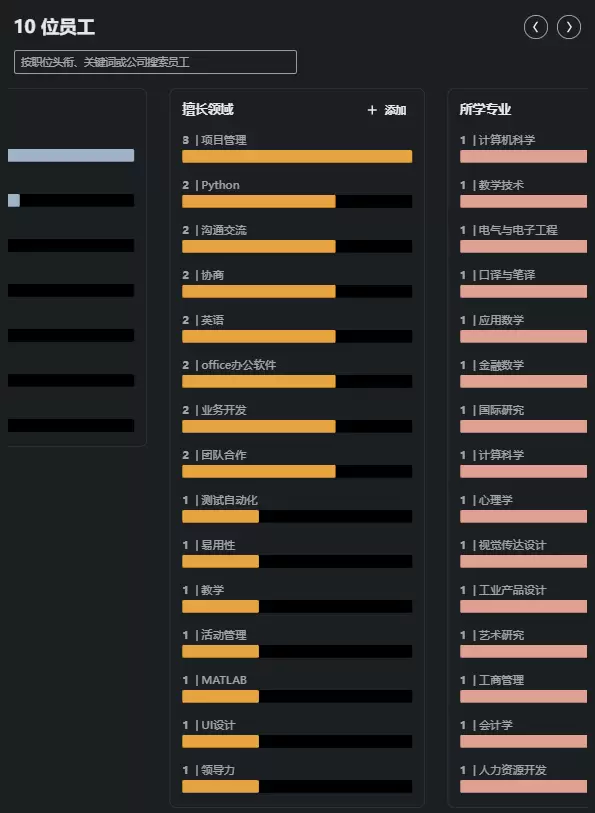
2.3.2 Co-founders

Co-founder: MaxYuudai
Max focuses on developing Web3 social graph and also serves as a business consultant at Astarter, dedicated to CARDANO’s DeFi ecosystem. Previously, he served as a product manager at ZB.com and a business development manager at Apple. He holds a Bachelor’s degree in Electrical and Electronic Engineering from Northeastern University in the United States.

Co-founder: Anthony
Graduated from South China Normal University, Anthony has worked in backend development at Tencent and ViabtcTechnology Limited, and has also founded ZaiYu Technology LTD.
2.3.3 Core Members

Business Director: Gustaf Munro
Gustaf currently serves as the Chief Operating Officer at Port3 Network, responsible for various DAO tools such as chatbots, Web3 Gleam (on-chain and off-chain tasks), social data insights, and community engagement. He has served as COO in different companies and has over 10 years of experience in the cryptocurrency field. Gustaf Munro holds a Bachelor’s degree in Psychology from Stellenbosch University.

Mihai Alexandru Radu Business Development Manager
Mihai holds the position of Business Development Manager at Port3 and has also served as Chief Marketing Officer at Krypto Playboy Capital. He is currently engaged in distributed office work. He has rich experience in investing in blockchain technology startups, community management, and marketing. In addition, he obtained a Bachelor of Law degree from the University of Bucharest in Romania.
2.4 Financing
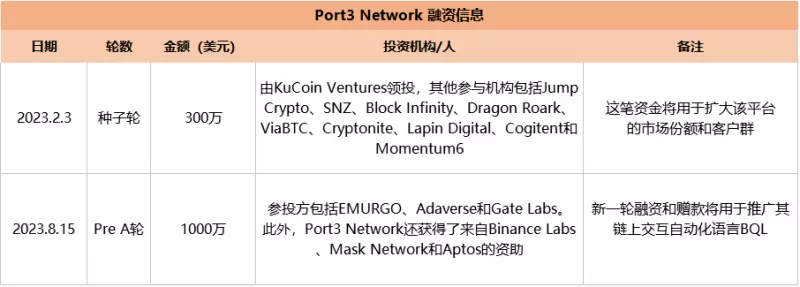
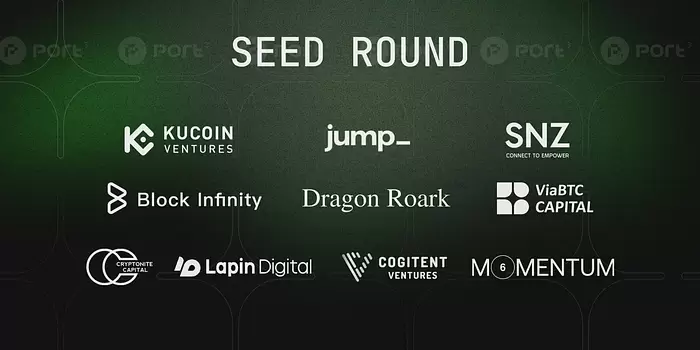
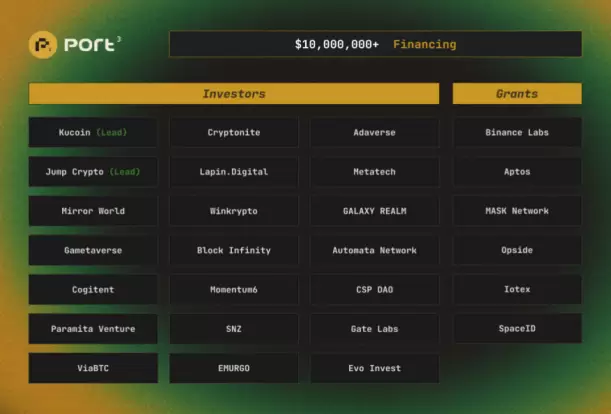
3. Business Analysis
3.1 Target Audience
1) Blockchain project teams
Port3 Network’s services can help blockchain project teams establish communities, aggregate various project activities and information in the Web3 ecosystem, and provide data analysis tools to support operational decision-making for blockchain teams. Port3’s social data layer can help project teams better understand various projects and activities in the Web3 ecosystem, enabling them to participate more effectively. In addition, Port3’s SoQuest platform can help project teams attract users to participate in project activities and reward users through task-based incentives. Robot Matrix provides support for upper-layer applications.
2) Web3 users
Port3 Network’s services can also enhance the experience for Web3 users. Port3 is developing a social data layer that aims to collect and analyze a wide range of user activities, including on-chain and off-chain data from both Web2 and Web3 sources. Users can earn rewards by participating in project activities and use Port3’s SoQuest platform to discover and engage in Web3 projects. Additionally, Port3’s social data layer can help users better understand various projects and activities in the Web3 ecosystem, enabling them to participate more effectively.
3.2 Business Segmentation
Port3 Network is a company dedicated to building Web3 social data infrastructure, with the following business segments:
1) Comprehensive social data analysis and application services: Port3’s social data infrastructure consists of three main stages: “data collection,” “data aggregation,” and “data application.”
2) Bot application services: SoQuest provides a comprehensive solution for analyzing and detecting social actions in collaboration with projects, covering multiple public chains. It offers functionalities such as token quotes, market sentiment, crypto airdrops, and transfers, and consolidates data from multiple social platforms to support data analysis and project participation verification.
3) Web3 task and mining ecosystem: SoQuest’s task platform provides diversified tasks and reward mechanisms for project parties and users, promoting the integration and participation of Web2 and Web3.
4) Comprehensive social data analysis and insight platform: SoGraph integrates Web2 and Web3 social data to attract more users to participate in data layer construction through diversified data applications and task incentives. The data includes member lists, social information, spam volume, and sentiment indicators, among others.
3.3 Business Description
1. Social Data Layer (Not Yet Implemented)
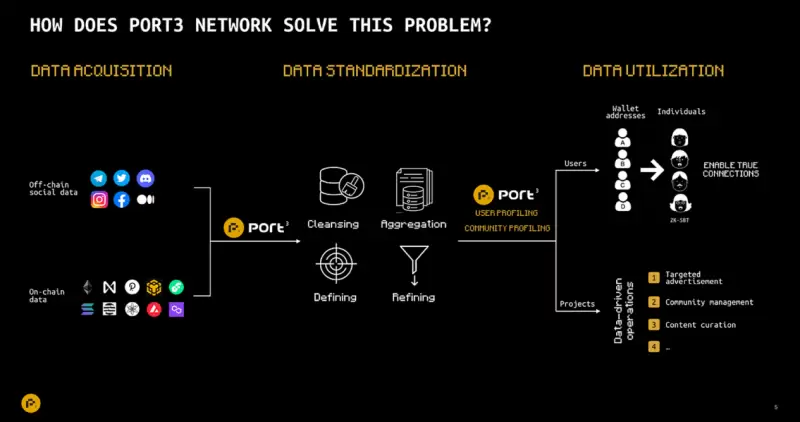
Diagram of Port3 Network's Social Data Layer
Port3’s social data infrastructure is divided into three main stages: “Data Collection,” “Data Aggregation,” and “Data Application”:
● Data Collection: This stage involves collecting on-chain and off-chain data (including Web2 and Web3 data), covering various user activities comprehensively.
● Data Aggregation: This stage includes a complete data processing workflow, further analyzing the collected data, compressing a large amount of low-density data into usable indicators, identity labels, and other data formats.
● Data Application: This stage is a key component of the Port3 infrastructure, providing support for upper-level application functions.
Port3 Product Matrix and Ecological Architecture
Currently, Port3 has built a set of interconnected products, including the Bot Matrix, SoQuest Task Platform, and SoGraph Analysis Platform, etc.

Current landscape of Port3 Network
2. Bot Matrix (Publicly Available)
The SoQuest Bot Matrix is used to analyze and detect social actions related to all projects collaborated with SoQuest. Projects that require off-chain tasks in the Telegram and Discord communities need to have bots. The bots cover more than 10 public chains and have functions such as token quotes, market sentiment, and conducting crypto airdrops and transfers between users.
The SoQuest bots can also read and organize data scattered across various social platforms, providing data analysis for project parties. Since the project started in 2022, the bots have covered over 5,000 top Web3 communities, 10 million users on Discord, and over 4 million users on Telegram.
Specifically,
1. The SoQuest bots will play a role in the following aspects:
● Verify users’ participation in activities, including whether users have joined the Discord/Telegram communities.
● Act as DAO tools, providing market quotes, smart airdrops, and other services.
2. How to invite bots to join users’ communities
● Select the bots and invite them to users’ Discord or Telegram communities.
● Grant them administrator roles.
● Enter the name of users’ community, and the community name will be found within 30 seconds.
3. SoQuest Task Platform (Publicly Available)
SoQuest is an open Web3 task platform. Project parties, KOLs, and DAO organizations create their own SLianGuaice on the platform and launch various on-chain and off-chain Quest activities, setting NFT or token rewards to attract participants to perform data mapping between Web2 activities and Web3, enabling projects to quickly acquire and convert users on Web2 platforms.
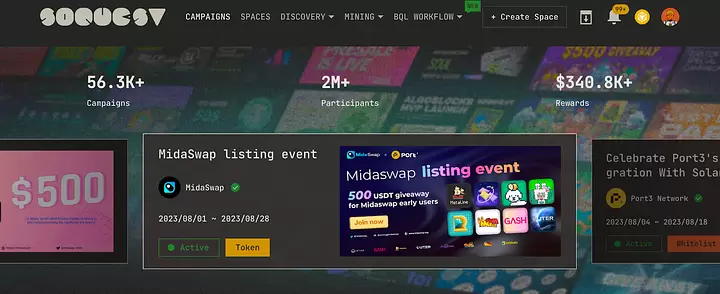
SoQuest Task Platform attracts over 2 million users to participate in activities
SoQuest has attracted nearly 800,000 users from over 100 countries worldwide. SoQuest supports more than 16 public chains and has integrated with over 1,800 project parties. Port3 has also launched the SoQuest mobile application, which is compatible with Android and iOS systems, for the construction of future user communities and the education of new users.
● Mining
Overview:
Total mining pool: 500 million, a total of 500 million gems will be allocated for this mining season
Effective time: July 1, 2023 – December 31, 2023
Other: SoQuest gems will serve as unique loyalty points, which will be deployed on the blockchain and will be seamlessly connected with SQT (abbreviation for SoQuest gems).
Overview of modes:
Quest Mining: 60 million (12% share)
Broadcast Mining: 10 million (2% share)
Trade Mining: 400 million (80% share)
Workflow Mining: 30 million (6% share)
Specific information:
1) Quest Mining
1.1 Prize Pool
Total of 60 million gems (including previously distributed gems)
1.2 Mining Rules
Users can participate in “mining tasks” through various activities on SoQuest, including introductory activities and FamLive Twitter Space activities. The maximum number of gems that can be obtained through tasks is 200 per day.
1.3 Participation Method
Create a user profile: Visit SoQuest.xyz, connect your wallet, and bind your Web2 account.
Participate in activities: On SoQuest.xyz/camLianGuaiign, you can participate in NFT/Token/whitelist tasks, introductory activities, and Twitter Space to collect gems.

2) Broadcast Mining
2.1 Prize Pool
10 million gems
2.2 Mining Rules
Each valid invitation will be counted, and both parties will receive 10 gems for each new user who completes the SoQuest registration and binds their Web2 account.
The inviter will automatically receive 1% of the gems from the invitee’s transaction rewards.
Early bird offer:
There are three mining stages, and the earlier users join, the more gems they can win. (For each user, the maximum number of gems that can be mined within 6 months is 35,000 gems)

2.3 Participation Method
Go to the mining page of SoQuest, copy the invitation link to invite friends to join.
Once the invited friend logs in to SoQuest and binds their Web2 account, the user is considered a successful invitee.
3) Trade Mining
3.1 Prize Pool
400 million gems
3.2 Mining Rules
Users can join SoQuest Swap to earn mining rewards.
Mining rewards will be distributed at 10:00 AM UTC+8 every day.
The distribution of gems is based on the previous day’s transaction fees and total trading volume.
3.3 Participation Method
Visit the trading page on SoQuest.xyz.
Select the source token and target token that the user wants to exchange. Make sure the user has enough balance of the source token.
4) Workflow Mining
In SoQuest, workflows are tools for executing transactions on the blockchain through meta-interactions and task flow interactions. Meta-interactions are based on on-chain basic transactions, while task flow interactions form a structured workflow to achieve specific goals.
4.1 Prize Pool
30 million gems
4.2 Mining Rules
By successfully running the workflow templates created by users, users will receive a reward of 10 gems, and each execution will increase the user’s cumulative mining output.
Note: Due to its implementation using workflow language, this mining category is more suitable for developers with certain technical proficiency.
4.3 Participation Method
● Create user’s BQL template
● The SoQuest/Port3 team will review user’s template: If the user’s template passes the review, it will be marked as ‘Verified’
● Other users can run the user’s template. For each successfully executed template, the user as the creator will receive 10 gems
5) KOL/Project Mining (Ended)
In KOL/Project Mining, the mining rewards are directly related to the number of participants in KOL or project creation activities. The more participants, the more generous the rewards.
Innovation – QaaS and BQL
SoQuest continues to innovate in the field of Quests, in addition to the earlier launch of Web3 task detection, it has recently introduced new technologies and services such as QaaS Widget and BQL.
● QaaS (Quest as a Service)
The Web3 task platform SoQuest has launched an innovative Quest solution called Quest-as-a-Service (QaaS). SoQuest QaaS provides a set of Widget plugins that support project parties to seamlessly integrate Quest features into any website, allowing users to participate directly. SoQuest QaaS provides a one-stop task management, reward management, and data analysis tool.
The QaaS Widget integrates the capabilities of Quest display, detection, and analysis into one Widget, which can be embedded into the project party’s own product webpage to achieve seamless integration. Users can view the activity status, overall project traffic growth, and conversion effects in the Dashboard, and have a clear understanding of the funnel. The competition of Quest has entered the second half, and the openness of QaaS not only reflects its functionality, but also deepens the capability of Quest services, marking the standardization of Quest services. In the process of using Quest features, users are billed based on credits, realizing usage-based billing.
● BQL (Blockchain Quest Language) is a language that automates complex on-chain operations. With BQL, users can directly become on-chain users of the project by simply clicking “run”, which executes an on-chain workflow and completes complex operations in one step. This is the ultimate way of Quest.
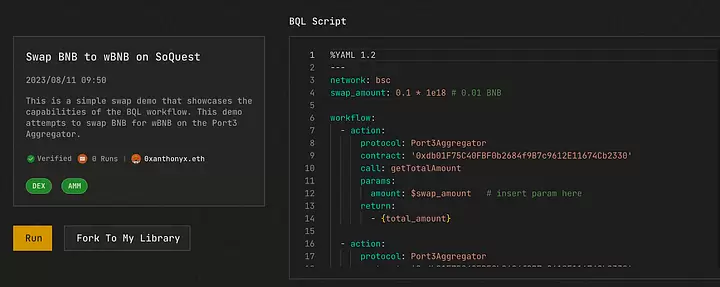
A BQL script for token exchange
BQL (Blockchain Quest Language) is an on-chain interaction language designed to lower the threshold, improve efficiency, and free up human resources in blockchain interaction. It allows users to interact with the blockchain by writing scripts that resemble natural language. These scripts can be automatically executed and transactions can be sent to the blockchain.
Key features of BQL:
- Syntax structure and readability: BQL has specific syntax structures that are simple and easy to read and write, reducing user learning costs and operational difficulties.
- Complex workflow operations: BQL can achieve complex workflow operations, allowing users to design multi-step interaction processes.
- Variable access and program interaction: BQL allows access to variables defined in the program, enabling interaction with the program. It can also interact with user wallets.
- Execution tracing and event triggering: BQL can trace program execution and define the combination of each operation based on return values and on-chain states. It includes event triggering mechanisms that can execute operations under specific conditions.
- BQL Workflow design:
BQL Workflow is a workflow corresponding to a BQL script, consisting of multiple interaction steps. Interaction steps can define operation combinations based on return values and on-chain states, allowing conditional execution and forming a complete on-chain interaction process.
- Examples of BQL scenarios:
BQL can be used to execute operations such as Swap, Add Liquidity, and Staking in one go, combining these operations into a complete workflow and simplifying the complexity of blockchain operations.
- BQL as a bridge between humans and the blockchain:
BQL serves as a bridge between humans and the blockchain. Its simple syntax allows non-programmers to understand the purpose of the script and edit it. It satisfies people’s intuitive and imprecise natural language descriptions while executing operations in a rigorous programming language. Through AI, people’s ideas can be mapped into BQL Workflows and completed with the help of auxiliary tools, turning ideas into practice.
- The impact of BQL on on-chain interactions:
The birth of BQL will change the way on-chain interactions are conducted, moving towards automated programs. However, humans still have the ultimate say because contracts and assets are still controlled by humans. BQL allows people to focus more on goals and ideas rather than skills, replacing operational rights with programs, but the overall operation still complies with blockchain contracts. In the Web3 field, there may be Web3 AI assistants that help users convert and implement ideas, achieving a higher degree of automation.
In the future, the combination of freely accessible Web2 + Web3 on-chain data (related events and data triggers) and BQL on-chain action execution can generate various interaction strategies and processes suitable for converting users for project parties, airdrop interactions, on-chain arbitrage, and various other scenarios. Most importantly, this aligns well with the context of the AI era, as it can achieve automated and intelligent control mechanisms for on-chain closed loops, serving as a prototype for on-chain AI assistants.
4. SoGraph Analysis Platform (currently only open to internal users)
The SoGraph Analysis Platform is similar to a combination of Lunarcrush and Nansen. It can track token market trends, market sentiment, KOLs, and general interactions in social spaces. It mainly combines off-chain data from various Web2 social platforms with on-chain data. Through ML and big data processing algorithms, it processes the data into market-required data indicators, member lists, social/spam email volume, sentiment indicators, etc.
These long-term comprehensive data can be used for the next stage of application scenarios. Diversified data applications and task incentives can attract more users to participate in data layer construction, thereby achieving a virtuous cycle.
3.4 Industry Space and Potential
Port3 Network has successfully launched two practical application projects: Bot Matrix and SoQuest. Currently, the SoQuest platform is rapidly becoming the focus of attention in the industry. In this analysis, we will focus on exploring the X-to-Earn track involved in these two products, as well as the Quest mode in this field. Next, let’s delve into the development process of these projects.
● Development trajectory
In summary, the development process of the QUEST platform can be divided into the following stages:
1. Web2 Marketing Tool Era: Gleam.io, as a marketing tool, cannot meet the requirements of Web3 on-chain tasks, especially when NFT rights are widely used for user acquisition and promotion, Gleam shows limitations.
2. Large-scale NFT Minting Exploration: Projects such as POAP and Project Galaxy try to build traffic platforms based on large-scale NFT minting, leading other competing products by more than half a year.
3. Insight into Web3 Task Detection Direction: In early 2022, SoQuest gained insights into the Web3 task detection direction and built the Quest platform.
4. Building Long-term Value Traffic Pool: The Quest platform builds a long-term value traffic pool through open source and deep cultivation strategies, attracting well-known projects in various public chain ecosystems, such as Sui, zkSync, and introducing multiple top projects in the Sui ecosystem such as Cetus, Suiet, Martian.
5. Unique Profit Model: By reconstructing the Quest experience and accumulating the platform’s value, ownership, fun, and social nature, the Quest platform has created a unique profit model, converting traffic into revenue.
6. Pursuing Long-term Relationships: The competition of the Quest platform has entered the second half, and it will focus on building long-term relationships. SoQuest is committed to building long-term relationships between projects and users. After users join the community, they should be able to participate in various activities and gradually upgrade from newcomers to OGs. Therefore, SoQuest has invested more effort in the organization of the SLianGuaice project.
In summary, these are important stages in the development process of the QUEST platform, each presenting unique characteristics and goals, driving the platform’s progress. So far, SoQuest has accumulated 500,000 registered users in the general traffic pool, covering 7 million community users. These community users can be reached through bots, completing the first step of traffic accumulation.
3.4.1 Classification
X-to-Earn is a broad classification referring to a range of projects and platforms based on blockchain technology that aim to allow users to earn cryptocurrencies (usually tokens) through various opportunities such as participating in activities, completing tasks, playing games, or other means.
Projects and platforms in this category can be classified based on their operational methods, target audience, and functional features.
Play-to-Earn:
These projects are typically blockchain-based gaming platforms where users earn token rewards by participating in games, completing tasks, selling virtual items, and more.
Work-to-Earn:
These projects allow users to earn tokens by completing specific tasks, providing skills, or services. Tasks may include data entry, content creation, design, programming, and more.
Learn-to-Earn:
These projects encourage users to participate in educational or training activities, learn new skills or knowledge, and earn tokens by completing courses, participating in discussions, and more.
Trade-to-Earn:
These projects allow users to earn tokens by participating in cryptocurrency or NFT trading, providing liquidity, or engaging in other trading activities.
Social-to-Earn:
These projects allow users to earn tokens by engaging in social interactions such as liking, commenting, sharing, and more.
NFT-to-Earn:
These projects allow users to earn token rewards or other benefits by buying, owning, and trading NFTs.
X-to-Earn is an important track, and Port3 Network can also be classified in this field. Through this project, users can continuously track the activities of relevant projects, learn and complete interactive skills through these activities, and obtain corresponding credentials.
● Subdivision of Quest Track
Nowadays, there is a wide variety of Web3 marketing tools. We have selected 19 representative projects from the track and classified them into three categories: traffic, education, and vertical subcategories based on the characteristics of the platforms. The different classifications are just the differences in the entry points of each project. For all these projects, we compare them based on some common indicators to determine their strengths.
Traffic:
Traffic platforms typically import user traffic for Web3 operators through the form of tasks, aiming to bring early-stage users and brand exposure to cryptocurrency projects, such as Galxe, SoQuest, TaskOn, and more.
Education:
Education platforms focus more on enhancing users’ understanding of different cryptocurrency projects, including guiding users to understand, learn, and use products for educational and growth purposes, such as Layer3, RabbitHole, Link3, and more.
Vertical Subcategories:
As task-oriented Web3 marketing tools, vertical subcategories tend to focus on specific areas such as GameFi, DAO, etc., such as Phi Land, Dework, Dequest, Real Player DAO, Carv, and more.
3.4.2 Market Size
The market size of Socialfi is 1.13 billion US dollars, with a trading volume of 92.48 million in the past 24 hours, and a ranking of 37 in Coingecko. In this vast and diverse market, in-depth analysis will be conducted on three different but related sectors: the largest Socialfi platform, the Web3 Social & Credentials field, and the Quest track.

Next, focusing on the Web3 Social & Credentials field, the total number of users has reached about 5.47 million, and nearly 83% of the users using the protocol are independent addresses. According to incomplete statistics from Dune, Galxe has the highest market share, reaching 41%, Cyberconnect accounts for 25%, and POAP accounts for 22%. The top three almost occupy 90% of the market share, especially Galxe, which has already shown a head effect.
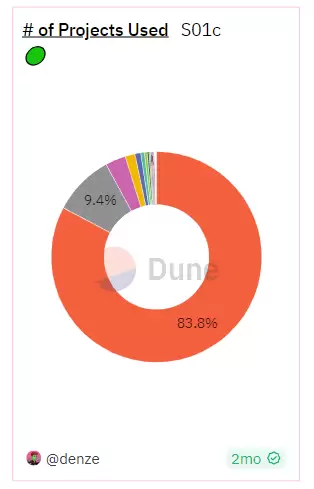



According to the basic data statistics provided by the project party, the Web3 marketing growth tool track started to emerge in 2021 and entered the explosive period of development in 2022. Except for the old Web3 task platform mainly represented by Galxe, which entered the market in 2021, the rest were launched in 2022. Therefore, this track belongs to the early track with a short development period.
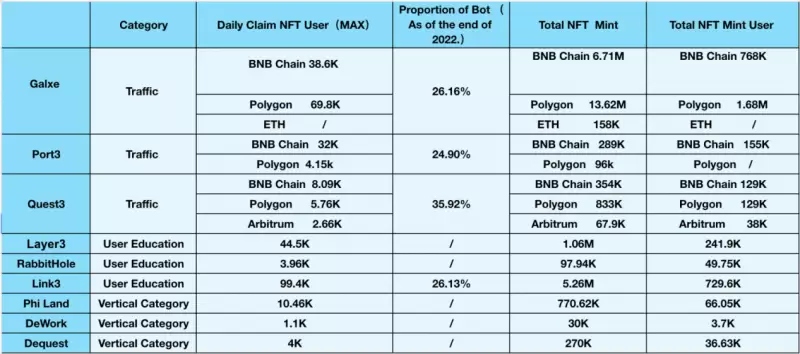
The data shows that there is a significant difference in user traffic between platforms. In the early market, Galxe, with its first-mover advantage and multi-chain layout, stands out and occupies a leading position. In comparison, other projects belong to the second echelon. This highlights the crucial role of first-mover advantage in occupying the market in the Web3 field and lays the foundation for future competition.
From the subdivision field to the overall sector, they together outline the diverse landscape of the Socialfi market. The largest Socialfi platform, the Web3 Social & Credentials field, and the Quest track collectively constitute the thriving social finance ecosystem in the Web3 world.
3.5 Business Data
● Operational Data
Overview
As of now, according to official data, Port3 Network has over 534,000 registered users, has hosted over 74,600 publishing activities, has partnered with over 2,200 partners, and continues to release new versions, with over 125 new versions released. The extensive cooperation network of Port3 Network and constantly innovative and upgraded product versions show a strong trend of user growth.
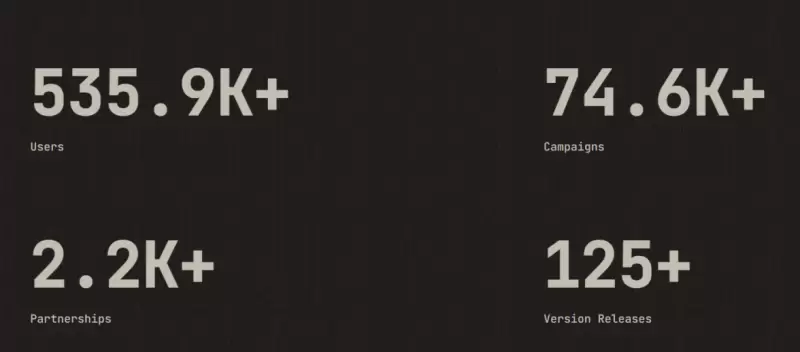
On-chain Data
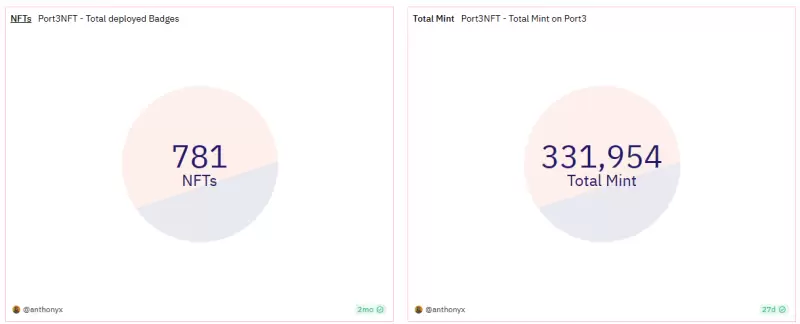
BNB Chain

Polygon Chain

BNB Chain

Polygon Chain
According to Dune’s data, as of September 19, 2023, a total of 331,900 NFTs have been minted on the BNB Chain, earning 781 badges. On the Polygon Chain, a total of 109,000 NFTs have been minted, and 627 events have been held. Observing the number of active users on the two chains daily, it can be seen that when the project first went online, users were more inclined to mint NFTs on the Polygon Chain. After a period of time, the number of users on the BNB Chain gradually increased, which may be related to more recent activities being held on the BNB Chain.
●SoQuest Mining Data
Overview: (As of September 19, 2023)
Total Mining Pool: 500 Million, 19.32 Million (3.86% of the total mining pool has been mined)
Quest Mining: 60 Million (12% of the total), with 89.72% of the 60 Million already mined
Broadcast Mining: 10 Million (2% of the total), with 1.71% of the 10 Million already mined
Trade Mining: 400 Million (80% of the total), with 8.46% of the 400 Million already mined
Workflow Mining: 30 Million (6% of the total), with 0.11% of the 30 Million already mined
In summary, Quest Mining has the highest level of participation, followed by Trading and Broadcast, while Workflow has the lowest level of activity.


Mining participation:
Quest Mining: Currently online for 256 days, with 189.41K participants
Broadcast Mining: Currently online for 256 days, with 17.53K participants
Trade Mining: Currently online for 57 days, with 2517 participants
Workflow Mining: Currently online for 40 days, with 4 participants.

Quest Mining

Broadcast Mining

Trade Mining

Workflow Mining
Currently, the cumulative mining quantity of the top ten mining addresses exceeds 30,000. The first place has a cumulative mining quantity of over 320,000, which is 5 to 6 times more than the second place, showing a significant advantage in mining for some addresses.
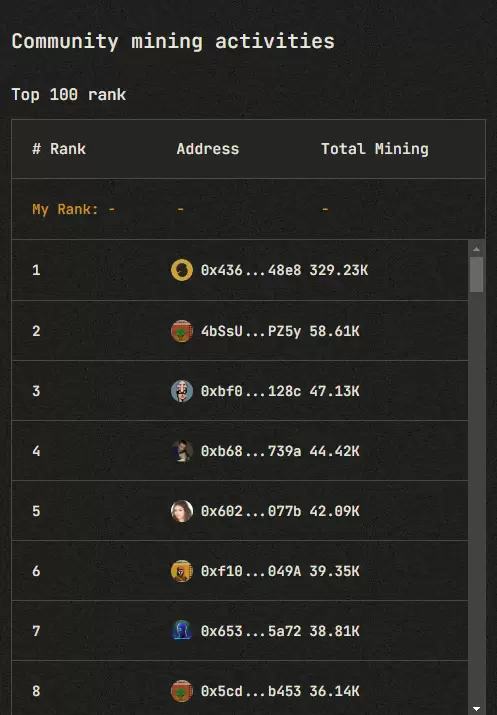
● Social media data
Twitter: 208,000 followers
Discord: 104,000 followers, 3,000+ daily active users (The Discord channel considers the language needs of different nationalities and has multiple language sections, conforming to the characteristics of social platforms. In the Discord community, there is high activity and most discussions are related to quest tasks.)
Telegram: 26,400 followers
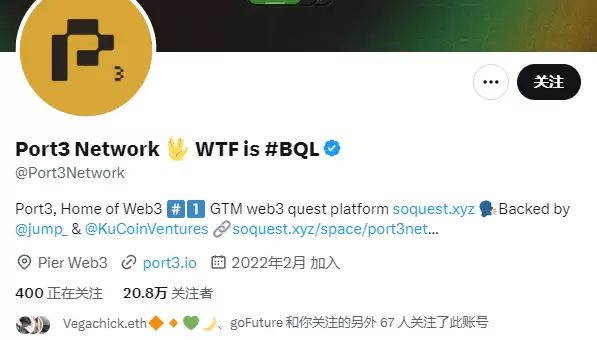
3.6 Project Competition Landscape
Considering that this project involves multiple products, from a data perspective, it may be more inclined to compare it with competing projects such as ARKHAM. On the other hand, if Bot Matrix is taken as the entry point, it may be more suitable to compare it with projects on the TG track. However, the product currently implemented and with a larger audience is SoQuest. Therefore, when comparing projects, the focus will be on SoQuest to gain a deeper understanding of its unique position and influence in the Web3 ecosystem.
3.6.1 Project Introduction
Galxe
Galxe is a Web3 credential data (DID) network. In terms of project planning, Galxe is built on an open and collaborative infrastructure to help Web3 developers and projects utilize digital credential data and NFTs to build better products and communities. For on-chain credentials, curators can provide subgraph queries or static snapshots. For off-chain credentials, the project has integrated with data sources such as Snapshot.org, Twitter, and Github. At the same time, by contributing to Galxe’s credential data network, curators will be rewarded when credentials are used in Galxe’s application modules, credential ORACLE engines, and credential APIs.
QuestN
QuestN is a social task platform that primarily drives growth and user engagement in Web3. Users can earn cryptocurrency by completing tasks and participating in advertisements. The platform integrates marketing, growth, and analytics, providing support for effective user acquisition. Advertisers can leverage permissionless on-chain/off-chain tasks as eye-catching forms of advertising and incentivize user participation through tokens, NFTs, whitelists, and Discord roles. Users participating in tasks can accumulate rewards, enhance community reputation, and unlock more social tasks.
3.6.2 Project Comparison
● Simple Comparison
Overall comparison of different projects in the same track
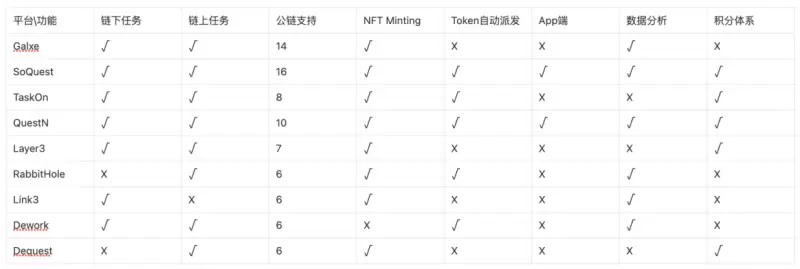
Comparison of mainstream functions and public chain support of each platform
Advantages of the QuestN project:
– Product features: QuestN is characterized by simplicity and speed. Users can complete task creation and publishing in three minutes.
– No threshold restrictions: QuestN is a completely permissionless task platform without any threshold restrictions. Anyone can publish tasks on the platform.
– Efficient task publishing and user-friendly experience: QuestN has quickly gained popularity among B-side user groups due to its efficient task publishing and user-friendly experience.
Disadvantages of the QuestN project:
– It is currently in the emerging stage, with relatively low market share.
– Currently, it only provides task platform services and lacks a diversified product line.
Advantages of the Galxe project:
– Strong background: Galxe is one of the largest data network platforms in the Web3 world. Its token Gal was first listed on important exchanges such as Binance, Kraken, Coinbase, and OKEx.
– Leading market share: Currently, Galxe holds a large market share, ranking first and having the most number of users. It has a clear first-mover advantage.
– Promising development prospects: Despite recent price fluctuations, Galxe still has broad development prospects and has laid a solid foundation for future development.
Disadvantages of the Galxe project:
– Unlike QuestN, Galxe is more of a token project rather than a product project, and its value and market performance are influenced by the cryptocurrency market.
– Compared to QuestN, Galxe has a relatively single product line and lacks diversification.
3.7 Token Model Analysis
Total Token Supply and Distribution
Currently, the project has not yet defined a token economic model. However, the Port3 Network project team in the community has expressed their plan to launch the token in Q4 of this year or Q1 of next year, depending on the market situation. They do not want to launch it too early to avoid harming the interests of users.

4. Preliminary Valuation
4.1 Core Question
Does the project have a reliable competitive advantage? Where does this competitive advantage come from?
The competitive advantages of Port3 can be summarized as follows:
1) Data integration advantage: Port3 is able to effectively bridge the gap between data and DApps in the Web3 ecosystem. By aggregating and standardizing off-chain and on-chain data through protocols, it creates a social data layer that is accessible and powerful for all Web3 use cases. This advantage belongs to the competitive advantage of data infrastructure.
2) Community Building Advantage: Port3’s key product SoQuest is described as one of the most popular Web3 Quest platforms, which can help projects build Web3 communities and aggregate various project activities and information. By launching activities to attract user participation and providing rewards, it provides tools and platforms that support Web3 community engagement and development. This advantage belongs to the competitive advantage of community building and user participation.
Overall, Port3’s competitive advantage comes from its focus on social data infrastructure and its ability to provide tools and platforms that support Web3 community development and participation.
What are the main variable factors in the operation of the project? Are these factors easy to quantify and measure?
1) User engagement: Including user activity, community participation, task participation, etc. This can be quantified and measured through user activity statistics, social interaction data, task completion rates, etc.
2) Task innovation and diversity: The number, diversity, and degree of innovation of different types of tasks can attract more user participation. This can be measured through task categorization, the speed of introducing new tasks, etc.
3) Community size and growth rate: The number of community members and their growth rate are important factors in project development and indicators of project popularity. This can be measured through community member registration, community activity, etc.
4) Market promotion effect: The impact of marketing and promotional activities on attracting users and increasing visibility of the project. This can be measured through the return on investment of marketing activities, social media followers, advertising click-through rates, etc.
5) Partnership relationships: Collaborating with other projects, platforms, or institutions can enhance the project’s influence and user participation. This can be measured through the number of collaborative projects, collaborative achievements, etc.
6) Technological upgrades and innovations: Continuously upgrading and innovating technology can maintain the project’s competitiveness and attractiveness. This can be measured through the frequency of technological updates, the introduction of new features, etc.
Most of these factors can be quantified and measured, especially those related to user activities, social interaction, and market promotion. These variables can be quantified and evaluated through data statistics, user feedback, market analysis, etc.
4.2 Main Risks
1. Strong competitors: In the social task platform, top platforms such as Galxe have already occupied a large market share. Competing with these platforms requires overcoming significant competitive pressures, including challenges in user stickiness, brand recognition, and community size.
2. Data security and privacy risks: As a combination of SocialFi’s social application infrastructure and application layer, the project will handle a large amount of user data, including sensitive information. Therefore, ensuring data security and privacy protection is a serious challenge. Any data leaks, security vulnerabilities, or hacker attacks can significantly affect user trust and project reputation.
3. Product launch risks: For the two products that have not yet been launched, there may be risks such as low user acceptance, product functionality not meeting expectations, and poor market response after launch. It is crucial to ensure that the products can iterate quickly and meet user needs.
5. References
1. Official website: https://Port3.io/
2. Official business description: https://medium.com/@Port3/Port3-Network-Web3-%E7%9A%84-%E5%8E%BB%E4%B8%AD%E5%BF%83%E5%8C%96%E7%A4%BE%E4%BA%A4%E6%95%B0%E6%8D%AE%E5%B1%82-f6c456556f44
3. Rootdata official website: https://www.rootdata.com/zh/member/Anthony%20Deng?k=MTQxODc%3D
4. Port3 LinkedIn: https://www.linkedin.com/comLianGuainy/Port3-Network/
5. Galxe: https://Galxe.com/protocol
6. QuestN official website: https://questn.com/
7. BQL – Chain interaction language in the AI era: https://foresightnews.pro/article/detail/37681
8. Understanding the development and ultimate battle of Web3 task-based marketing tools: https://foresightnews.pro/article/detail/33791
9. Dune Data Dashboard: https://dune.com/denze/Web3-social
We will continue to update Blocking; if you have any questions or suggestions, please contact us!
Was this article helpful?
93 out of 132 found this helpful
Related articles
- Su Zhu being sentenced to prison, will the four-month imprisonment time be extended?
- Amazon’s participation and the skyrocketing value of AI company Anthropic become FTX’s biggest hope of repaying the debt?
- LianGuai Daily | Li Xiaolai responds to the Mixin incident; Hong Kong Securities and Futures Commission releases multiple lists of virtual asset trading platforms.
- Interview with Former President of Polygon Labs Games will be a key factor in driving the mainstream adoption of cryptocurrencies
- Interpreting Namada A Modular Privacy Solution Serving the Multi-Chain Ecosystem
- RWA Potential Exploration The Next Large-Scale Application Track after Stablecoins?
- UBI Development History The Combination of Utopia and Fantasy





